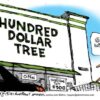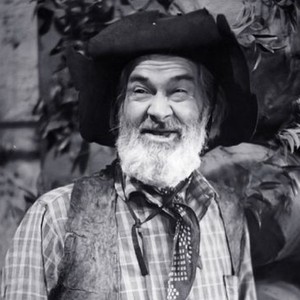Gene Autry and Autry Museum of the American West
![]()
Autry Museum of the American West

From Wikipedia, the free encyclopediaJump to navigationJump to search
| Wikimedia | © OpenStreetMap | |
| Established | 2003 |
|---|---|
| Location | 4700 Western Heritage Way, Griffith Park Los Angeles, California |
| Coordinates |  34.1487°N 118.2813°WCoordinates: 34.1487°N 118.2813°WCoordinates:  34.1487°N 118.2813°W 34.1487°N 118.2813°W |
| Type | Western and American Indian |
| Director | W. Richard West Jr. |
| Website | theautry.org |
Entrance to museum sectionTower at Autry MuseumDisplay of Gene Autry memorabilia, including his iconic Martin D-45 guitar, the first one madeThe museum owns the iconic painting American Progress (1872), by artist John GastExterior cascade exhibit at Autry Museum
The Autry Museum of the American West is a museum in Los Angeles, California, dedicated to exploring an inclusive history of the American West. Founded in 1988, the museum presents a wide range of exhibitions and public programs, including lectures, film, theater, festivals, family events, and music, and performs scholarship, research, and educational outreach. It has two sites and attracts about 150,000 visitors annually.[1]
In 2013, it extensively redesigned and renovated the Irene Helen Jones Parks Gallery of Art and the Gamble Firearms Gallery in its main building. In its related opening exhibit for the Parks Gallery, Art of the West, the new organization enabled material to be presented in relation to themes rather than chronology, and paintings were shown next to crafts, photography, video and other elements in new relationships.[1]
Contents
Locations[edit]
The Autry Museum of the American West has two sites, about 8 miles (13 km) apart:
- Griffith Park 4700 Western Heritage Way, Los Angeles, California, 90027
- Mt. Washington, 234 Museum Drive, Los Angeles, California, 90065 (Southwest Museum of the American Indian building and ethnobotanical garden, open on Saturdays, 10:00 a.m. to 4:00 p.m.)
Elements[edit]
The Autry was established in 1988 by actor and businessman Gene Autry as “Gene Autry Western Heritage Museum” to explore and share the comprehensive story of the American West and its multiple cultures and interpret its significance.[2] Its Griffith Park collection includes 21,000 paintings, sculptures, costumes, textiles, firearms, tools, toys, musical instruments, and other objects.[3] The museum presents contemporary and historical exhibitions, year-round programs for children, intellectual forums, and the Native Voices at the Autry performing arts series.
Native Voices at the Autry Museum of the American West has been the only equity theater that has only focused on producing new works by Native American, Alaska Native, and First Nation playwrights since 1995.[4] Randy Reinholz (member of Oklahoma’s Choctaw nation) and his wife Jean Bruce Scott have run this theater program that runs out of the Museum for 20 years. Native Voices has since been able to produce over 34 full productions, gone on over 20 tours, with 23 new play festivals and 13 Native playwrights.[5] Native Voices is a crucial part of the Autry’s mission to promote art history and cultures of the American West.[4]
The museum is located in Griffith Park across from the Los Angeles Zoo. The 4,000-square foot Parks Gallery was renovated in 2013 and has been organized into three theme areas: Religion and Ritual, Land and Landscape, Migration and Movement, and also contains two mini galleries with revolving exhibits. This enables flexible curating of the museum’s extensive materials: paintings can be placed near textiles, photographs, pottery and videos. The spaces can also be used for more flexible programming.[1]
The Gamble Firearms Gallery also was renovated in 2013. It now shows more of the context and place of firearms in the Old West; curators grouped firearms by themes: “hunting and trapping, the impact of technology on firearms, the conservation movement and the West in popular culture.”[1] This is part of the Western Frontiers: Stories of Fact and Fiction Gallery.[1]
- The Autry’s Southwest Museum of the American Indian Collection of Native American art is one of the most significant of its kind in the United States, second only to the Smithsonian Institution National Museum of the American Indian. The 238,000-piece collection includes 14,000 baskets, 10,000 ceramic items, 6,300 textiles and weavings, and more than 1,100 pieces of jewelry. It represents work by indigenous peoples from Alaska to South America, with an emphasis on cultures of California and the Southwestern United States.[3]
- The Autry Institute includes the collections of the Braun Research Library and the Autry Library. It is a research and publishing enterprise that produces and supports scholarly work in Western history and the arts.[3] In 2002, the Women of the West Museum of Colorado merged with the Institute. This has broadened the scholarly and educational emphasis to include gender issues and women’s experiences in the American West.[6]
From 2004 to 2015, it was known as the “Autry National Center of the American West and in October 2015, the museum began using the name “Autry Museum of the American West” to describe its “principal activities as a museum.” “[7]
References[edit]
- ^ Jump up to:a b c d e Brenda Rees (October 3, 2013). “Galleries of Change”. Pasadena Weekly. Retrieved May 14, 2019.
- ^ Edward Rothstein (September 22, 2013). “A Museum Works to Reinvent Itself, as Well as the American West”. The New York Times. Retrieved May 14, 2019.
- ^ Jump up to:a b c “Museums for America” (PDF). Institute of Museum and Library Servivces. October 1, 2017. Retrieved May 14, 2019.
- ^ Jump up to:a b Gelt, Jessica (March 27, 2017). “NEA helps the Autry Museum provide a rare platform for Native American Playwrights”. Los Angeles Times. Retrieved May 14, 2019.
- ^ Weinert-Kendt, Rob (March 20, 2018). “Raising Native Voices, Then Amplifying Them. American Theater”. Retrieved May 14, 2019.
- ^ “Women of the West Museum merges with Autry Museum”. Denver Business Journal. March 8, 2002. Retrieved May 14, 2019.
- ^ “What Is the Autry?”. Autry Museum. May 27, 2016. Retrieved May 14, 2019.
Further reading[edit]
- “Your guide to Gene Autry, America’s Favorite Singing Cowboy,” pamphlet from the Autry Museum of the American West
- “Pocket guide: Explore the past, present, & future of the American West,” pamphlet from the Autry Museum of the American West
External links[edit]
| Wikimedia Commons has media related to Autry National Center. |
- Museums in Los Angeles
- Griffith Park
- American West museums in California
- Native American museums in California
- Art museums and galleries in Los Angeles
- History museums in California
- Women’s museums in California
- Museums established in 1988
- Organizations established in 1988
- 1988 establishments in California
- Native American arts organizations
- Native Americans in Los Angeles
Navigation menu
- Not logged in
- Talk
- Contributions
- Create account
- Log in
Search
Contribute
Tools
- What links here
- Related changes
- Special pages
- Permanent link
- Page information
- Cite this page
- Wikidata item
Print/export
In other projects
Languages
Gene Autry
From Wikipedia, the free encyclopediaJump to navigationJump to searchFor other uses, see Gene Autry (disambiguation).”The Singing Cowboy” redirects here. For the 1936 film, see The Singing Cowboy (film).
| Gene Autry | |
|---|---|
| Autry in the 1940s | |
| Born | Orvon Grover Autry September 29, 1907 Tioga, Texas, U.S. |
| Died | October 2, 1998 (aged 91) Los Angeles, California, U.S. |
| Burial place | Forest Lawn, Hollywood Hills Cemetery, U.S. |
| Other names | The Singing Cowboy, Gene Michaels |
| Occupation | Singersongwriteractormusicianrodeo performerbaseball owner |
| Years active | 1925–1964 |
| Spouse(s) | Ina Mae Spivey(m. 1932; died 1980)Jacqueline Ellam (m. 1981) |
| Relatives | Randy QuaidDennis Quaid(first cousins twice removed) |
| Musical career | |
| Genres | CountryWestern |
| Instruments | Guitarvocals |
| Labels | ColumbiaOkehPerfectConquerorVictor |
| Website | geneautry.com |
Orvon Grover “Gene” Autry[1] (September 29, 1907 – October 2, 1998),[2] nicknamed the Singing Cowboy, was an American singer, songwriter, actor, musician, rodeo performer, and baseball owner who gained fame largely by singing in a crooning style on radio, in films, and on television for more than three decades beginning in the early 1930s. Autry was the owner of a television station, several radio stations in Southern California, and the Los Angeles/California Angels Major League Baseball team from 1961 to 1997.
From 1934 to 1953, Autry appeared in 93 films, and between 1950 and 1956 hosted The Gene Autry Show television series. During the 1930s and 1940s, he personified the straight-shooting hero—honest, brave, and true.[3] Autry was also one of the most important pioneering figures in the history of country music, considered the second major influential artist of the genre’s development after Jimmie Rodgers.[3] His singing cowboy films were the first vehicle to carry country music to a national audience.[3] In addition to his signature song, “Back in the Saddle Again” and his hit “At Mail Call Today“, Autry is still remembered for his Christmas songs, most especially his biggest hit “Rudolph, the Red-Nosed Reindeer” as well as “Frosty the Snowman“, “Here Comes Santa Claus“, and “Up on the House Top“.
Autry is a member of both the Country Music Hall of Fame and the Nashville Songwriters Hall of Fame, and is the only person to be awarded stars in all five categories on the Hollywood Walk of Fame, for film, television, music, radio, and live performance.[4] The town of Gene Autry, Oklahoma, was named in his honor, as was the Gene Autry precinct in Mesa, Arizona.[5]
Contents
- 1Life and career
- 2Personal life
- 3Legacy
- 4Discography
- 5Filmography
- 6See also
- 7Further reading
- 8Notes
- 9References
- 10External links
Life and career[edit]
Early years[edit]
Orvon Grover Autry was born September 29, 1907, near Tioga in Grayson County in north Texas,[6] the grandson of a Methodist preacher. His parents, Delbert Autry and Elnora Ozment, moved in the 1920s to Ravia in Johnston County in southern Oklahoma. He worked on his father’s ranch while at school. After leaving high school in 1925, Autry worked as a telegrapher[7] for the St. Louis–San Francisco Railway. His talent at singing and playing guitar led to performing at local dances.
Singing career[edit]
Gene Autry with Smiley Burnette, 1934
While working as a telegraph operator in Chelsea, Oklahoma, Autry would sing and accompany himself on the guitar to pass the lonely hours, especially when he had the midnight shift. This later got him fired. One night, he was encouraged to sing professionally by a customer, humorist Will Rogers, who had heard him singing.[8][9][10]











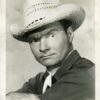










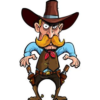




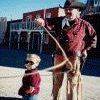





![Lieutenant-Colonel Robert Rogers (7 November 1731 – 18 May 1795) was a British Army officer and frontiersman. Born in Methuen, Massachusetts, he fought in King George’s War, the French and Indian War and the American Revolutionary War. During the French and Indian War, Rogers raised and commanded Rogers’ Rangers, a ranger unit trained for carrying out asymmetric warfare.[2][3](https://www.cowboyron.com/wp-content/uploads/2022/05/1262463_580743685323360_2133853937_o1-1-150x150.jpg)










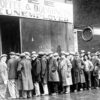





![Billie Joe Armstrong & Norah Jones – Silver Haired Daddy Of Mine [Music Video]](https://www.cowboyron.com/wp-content/uploads/2022/11/Al_St._John1-100x100.jpg)








